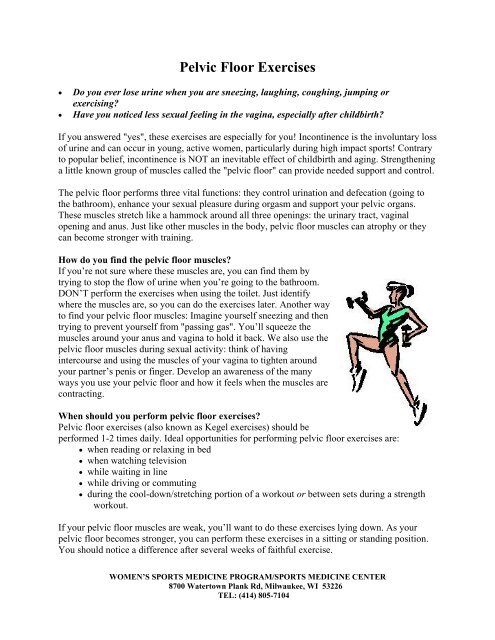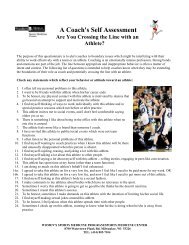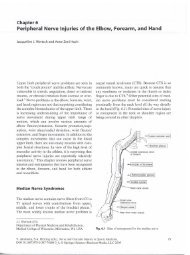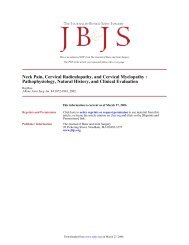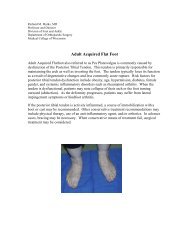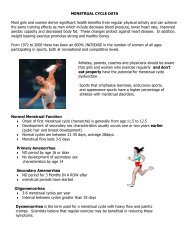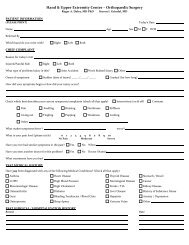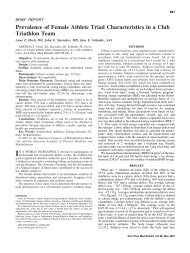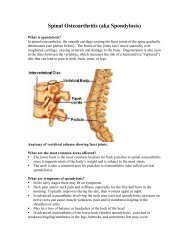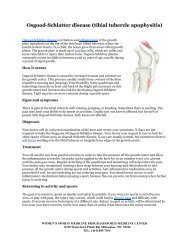Pelvic Floor Exercises
Pelvic Floor Exercises
Pelvic Floor Exercises
- No tags were found...
Create successful ePaper yourself
Turn your PDF publications into a flip-book with our unique Google optimized e-Paper software.
<strong>Pelvic</strong> <strong>Floor</strong> <strong>Exercises</strong>Do you ever lose urine when you are sneezing, laughing, coughing, jumping orexercising?Have you noticed less sexual feeling in the vagina, especially after childbirth?If you answered "yes", these exercises are especially for you! Incontinence is the involuntary lossof urine and can occur in young, active women, particularly during high impact sports! Contraryto popular belief, incontinence is NOT an inevitable effect of childbirth and aging. Strengtheninga little known group of muscles called the "pelvic floor" can provide needed support and control.The pelvic floor performs three vital functions: they control urination and defecation (going tothe bathroom), enhance your sexual pleasure during orgasm and support your pelvic organs.These muscles stretch like a hammock around all three openings: the urinary tract, vaginalopening and anus. Just like other muscles in the body, pelvic floor muscles can atrophy or theycan become stronger with training.How do you find the pelvic floor muscles?If you’re not sure where these muscles are, you can find them bytrying to stop the flow of urine when you’re going to the bathroom.DON’T perform the exercises when using the toilet. Just identifywhere the muscles are, so you can do the exercises later. Another wayto find your pelvic floor muscles: Imagine yourself sneezing and thentrying to prevent yourself from "passing gas". You’ll squeeze themuscles around your anus and vagina to hold it back. We also use thepelvic floor muscles during sexual activity: think of havingintercourse and using the muscles of your vagina to tighten aroundyour partner’s penis or finger. Develop an awareness of the manyways you use your pelvic floor and how it feels when the muscles arecontracting.When should you perform pelvic floor exercises?<strong>Pelvic</strong> floor exercises (also known as Kegel exercises) should beperformed 1-2 times daily. Ideal opportunities for performing pelvic floor exercises are: when reading or relaxing in bed when watching television while waiting in line while driving or commuting during the cool-down/stretching portion of a workout or between sets during a strengthworkout.If your pelvic floor muscles are weak, you’ll want to do these exercises lying down. As yourpelvic floor becomes stronger, you can perform these exercises in a sitting or standing position.You should notice a difference after several weeks of faithful exercise.WOMEN’S SPORTS MEDICINE PROGRAM/SPORTS MEDICINE CENTER8700 Watertown Plank Rd, Milwaukee, WI 53226TEL: (414) 805-7104
How do you perform pelvic floor exercises?There are two types of exercises which you should do each day: long holds and shortcontractions.Long holds:Start by focusing your attention on the pelvic floor area. Squeeze or "lift and hold" the pelvicfloor muscles for 5 seconds duration. Then release. When you do this exercise, visualize acircle closing as the muscles tighten and opening as they relax. "Draw your muscles in" at theurinary, vaginal and anal openings. Gradually increase the length of your hold to 10 seconds.Start with 3 repetitions. When you’re able to hold for 10 seconds, gradually increase thenumber of repetitions to 10-30. Let your muscles rest in between each repetition. (If you holdfor 5 seconds, relax for 5 seconds. If you hold for 10 seconds, relax for 10 seconds.)Short contractions:Focus your attention on your pelvic floor muscles. Pull up and in, hold just 1-2 seconds andrelax. Repeat these quick contractions until your muscles are too tired to continue. Build upto 30 repetitions.Important technique tips: Start with as many repetitions as you can tolerate. Progress slowly by graduallyincreasing the number of repetitions or the length of your long holds. Make sure your stomach, buttocks and inner leg muscles all stay relaxed during pelvicfloor exercises. Don’t strain or bear down. The only muscles contracting or movingshould be your pelvic floor. Don’t hold your breath during pelvic floor exercises. If you count out loud, that mayprevent you from holding your breath. Try breathing out as you squeeze your pelvicfloor. "Exhale on the effort" is a good slogan to remember. It’s tricky at first, but you’llget it! Once you have a solid routine of pelvic floor exercises in place, prevent stress urinaryincontinence by training your pelvic floor to be strong during an abdominal contractionor while coughing or sneezing. When you sense a sneeze or cough coming, squeeze yourpelvic floor to support your bladder.WOMEN’S SPORTS MEDICINE PROGRAM/SPORTS MEDICINE CENTER8700 Watertown Plank Rd, Milwaukee, WI 53226TEL: (414) 805-7104


